ioSafe SoloPRO: Disaster Proofing Your Storage Needs
by Ganesh T S on April 9, 2012 6:00 PM EST- Posted in
- Storage
- IT Computing
- ioSafe
ioSafe holds a number of patents related to disaster proofing of digital storage media. ioSafe's CEO Robb Moore is the primary inventor of most of those patents. In this section, we will take a brief look at the various patents related to the ioSafe SoloPRO. Note that the SoloPRO might not be using all of the inventions mentioned in the patents below.
Fire Resistant, Forced Air Cooled Enclosure for Computer Digital Data Storage Device (US Patent No. US 7,211,742 B2):
This patent provides details of how ioSafe is able to design a fireproof enclosure despite the presence of a fan to cool the operating contents. Even though a single hard disk drive used as a backup target (such as in the SoloPRO) might not require active cooling, it is definitely a necessity in multi-disk configurations.
The invention presents a fireproof enclosure with an inlet for air to flow through (aided by a fan) and cool the storage device inside. However, this inlet could prove detrimental in case of a fire (where the exposure of the internal storage device to high temperatures / fire through the inlet could cause its destruction).
To solve this problem, the opening is protected by a fire resistant movable hatch. This movable hatch automatically closes upon reaching a predetermined temperature (which is something not reached by the drives during operation, and also below something which can actually damage the drives). The closing mechanism could use any temperature sensitive element (eutectic metal / plastic / rubber / wax etc.) coupled with either actuation springs that expand or contract to close the hatch or just rely on gravity to bring the hatch down (if the temperature sensitive element is actually supporting the top of the enclosure). An alternative to a mechanical closing system is an electronic solenoid based system where the actuator is a thermocouple.
Example of springs being used as actuators to close hatch held in place by a temperature sensitive element (Diagrams from Patent No. US 7,211,742 B2). Note that this is not the actual mechanism used in the SoloPRO.
In each of the above methods, a temperature sensitive element is activated when a threshold temperature is reached, which protects the internal data storage device from the high external temperature.
Fire Resistant and/or Water Resistant Enclosure for Operable Computer Digital Data Storage Device (US Patent No. US 2009/0050365 A1):
This patent details inventions which provide for hatchless enclosures (with or without fans), water resistant and non-actively cooled enclosures (with or without hatches), and enclosures with meltable materials which can close off ventilation passageways in the case of a fire.
The movable hatches described in the previous patent tend to increase the cost of the device. In this patent, ioSafe describes how a 1.5 inch thick gypsum wall with small sized vents could support fan-based cooling while also protecting the internal contents from the high temperatures outside. In the presence of a fire, the air inside expands and gets forced out through the vents. This outward air flow counteracts the flow of external heat through the vents. The vents are designed to be maze-like to reduce the amount of external heat which can get inside. Of course, the inner chamber and the vents have to be appropriately sized to provide fire resistance and prevent data loss.
Labyrinthine vents to allow for expanding internal air volume to counter the external heat (Diagram from Patent No. US 2009/0050365 A1)
The SoloPRO is also water resistant, and this patent also describes the water resistant and heat conducting covering for the data storage device. In addition, the patent also presents how intumescent or meltable materials can be used to seal off the inlets for the power and data cables of the data storage device.
Water resistant pouch with an embedded finned heat sink to cover the storage media. Note that the SoloPRO's water resistant pouch doesn't have a finned heat sink (Diagram from Patent No. US 2009/0050365 A1)
The water resistant pouch is made of heat conducting material so that the heat produced by the drive is taken away. It could be either a metallic foil or a more rigid enclosure. The enclosure could also internally contain fins for better thermal performance. The metallic pouch is provided with an elastomeric coating. A gasket around the perimeter of the pouch provides a water resistant enclosure.
Fire Resistant and Water Resistant Enclosure for Operable Computer Digital Data Storage Device (US Patent No. US 7,843,689 B2):
This patent is the one on which a majority of the features of the SoloPRO are based. It improves upon the inventions detailed in the previous two patents by:
- Super-saturating the enclosure (made of gypsum or concrete) with water, and preventing its evaporation with vapor barriers on both the internal and external walls of the enclosure (during a fire, this barrier melts and the water in the walls absorb the latent heat of vaporization, allowing the extension of the time over which the internal storage device is protected from damage).
- Not allowing the movable hatch design to completely close off the internal unit, but allow a slight opening for superheated steam to escape (can be used for high power devices - 20 to 2000 W)
- Providing ventilation passageways for expanding air and steam inside the unit in case of a fire (in hatchless designs)
State of the enclosure prior to fire exposure. Note the size of the vents near 91 and 92 which allow for flowing air to cool the storage media during normal operation (Diagram from Patent No. US 7,843,689 B2)
State of the enclosure after fire damage. Note that the size of the vents near 91 and 92 have decreased, but they still allow steam built up internally to escape outside (Diagram from Patent No. US 7,843,689 B2)
The water resistant pouch used in this invention is similar to the one in the previously described patent.


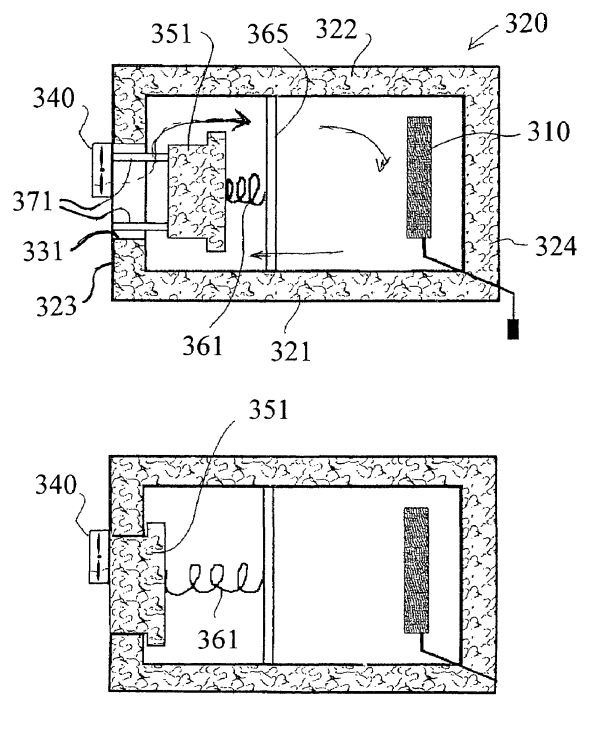
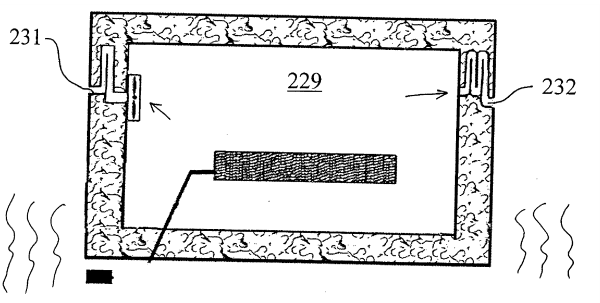
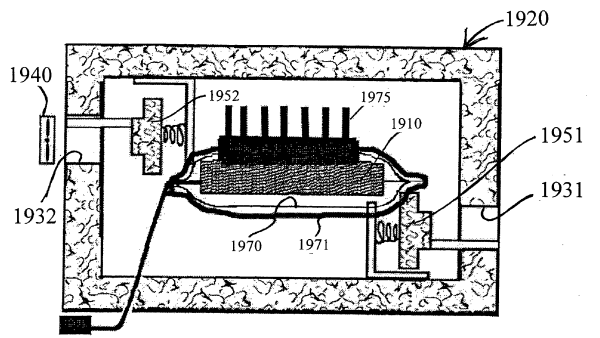
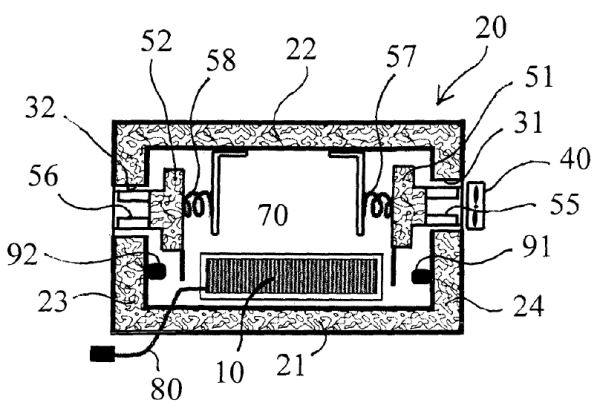
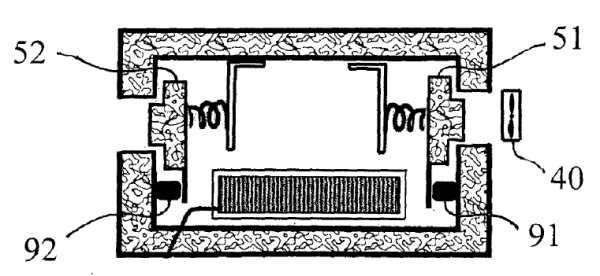








34 Comments
View All Comments
ganeshts - Monday, April 9, 2012 - link
Many companies are still paranoid about cloud storage (security and other concerns).Syncing data in real time from the main office to the cloud is also dependent on the bandwidth available.
Yes, the cost is a concern. I am hoping that ioSafe can easily scale up the number of disks without increasing the cost of the enclosure too much.
zanon - Monday, April 9, 2012 - link
Onsite matters for rapid recovery from hardware failure, but in this age I think it's highly questionable for serious disaster recovery. Syncing to your own offsite location (between friends and family for example) offers far more robust protection for nothing beyond the hardware, which not needing to be "disaster proof" per se carries no premium. Good cloud backup is cheap and even more reliable. Encryption means that there are no inherent security issues beyond one's own. A $200 premium will buy more then *5 years* of cloud service for something like CrashPlan+.This seems like an interesting product, but with a pretty niche application of areas that do not have broadband access. Those applications absolutely do exist of course, but it's a shrinking market, and even then it'd still generally be smart to buy some duplicate media and rotate it offsite manually.
robb.moore - Tuesday, April 10, 2012 - link
Hi zanon and cloud surely-Over the years, we've experience numerous disasters with users backing up on nearly 100K ioSafe units . When used in conjunction with our Data Recovery Service, our users are better than 99.9% success of retaining their data - human error, hdd crashes, fires, floods, etc. ioSafe is making a difference in our customer's lives. Much better imo than the 50% of people that have typically lost data.
Our opinion is that the public cloud is great for backing up 20, 30 or maybe even 100GB but it starts to break down after that. It's faster to FedEx a TB across the country than to pipe it over the cloud. If you're a small business, you need to get your business back tomorrow - not next week after all your customers have gone somewhere else.
I have 2TB+ at home on my Synology NAS and CrashPlan, Mozy, etc. simply isn't an option for people in this position as "unlimited" cloud storage is "limited" to data files on a PC and doesn't backup the OS, programs or NAS devices. Rotating media offsite regularly is a pain and I often can't remember to do it. I use a SoloPRO as a backup target for my NAS. With that I get fire, flood, RAID, NAS, "private cloud access" and backup - all without having to install any additional software on my computer.
Disaster proofing terabytes of data, imaging multiple PC OS's, programs, settings, etc. is tough. There's no magic bullet for every situation. ioSafe technology is intended to be used wherever data sits vulnerable and be a simple "disaster plan in a box" solution for data backup and protection.
Combined with cloud and offsite vaulting as you like - ioSafe technology can be layered in wherever vulnerable data exits or your recovery time objective demands.
Great comments - thanks!
-Robb
Robb Moore
CEO
ioSafe
Samus - Thursday, April 12, 2012 - link
Robb, this is great technology. I've been an IT consultant for small business for 10 years and have a number of clients, especially those with small medical practices, that are paranoid about off-site backup solutions. Most of my clients use Carbonite, iDrive, or CTERA without hesitation, but there are a few they just rely on local tape backups or external hard drives that have no fire protection. I try to have clients always keep a rotating tape or hard drive in a fire safe, but there is a lot of room for human error as they can be weeks out of date when someone forgets.I will be trying one of your drives shortly. It's mind boggling you are the first to market something like this when it has been a field waiting to be exploited for 30+ years.
stolid - Monday, April 9, 2012 - link
It seems like it would defeat the purpose if the drive were to fail in a typical manner. This would be cooler if it were two drives within the enclosure in RAID1.robb.moore - Tuesday, April 10, 2012 - link
Thanks stolid-We're constantly working on new products with ioSafe technology - stay tuned!
That being said - the ioSafe SoloPRO is meant as a backup target - not primary storage. At ioSafe we highly recommend that our users follow a minimum of our 3-2-1 Backup Rule:
<> Keep at least 3 complete copies of your data
<> Keep them on at least 2 different devices
<> 1 copy should be on an ioSafe, taken offsite or disaster proofed in someway
Even a RAID 1 device can be accidentally formated or have RAID controller failure causing all the data to be lost. RAID is not "backup". Humans have, many times, pulled the wrong "dead" drive from a RAID 5 array only to discover that the entire array is now corrupt.
Again - just a guideline. Everybody's situation is a little different. Do what makes sense for your data, computer, business, etc.
Thanks!
-Robb
Robb Moore
CEO
ioSafe
P_Dub_S - Monday, April 9, 2012 - link
I have a 1TB Solo and it works great in conjunction with Mozy backup. The server is on a RAID 5 that backs up the entire server locally on the ioSafe incase more than one drive dies or fire/water damage. Then I use Mozy to backup the company data. Very cost efficient backup solution for a small business with under 20 users.robb.moore - Tuesday, April 10, 2012 - link
that's perfect - thanks P_Dub_S. Layering different technologies together to make a disaster recovery plan that works for you is the way to do it.We have 3 ioSafe's go through the Joplin tornadoes. All the offices were destroyed. They recovered all servers the next day.
Tough to do via a pure cloud solution - pushing a pulling TB's of data up and down across an internet connection that's a shredded wire :) The added problem of all the original program disks scattered across the neighboring county!
-Robb
Robb Moore
CEO
ioSafe
zanon - Monday, April 9, 2012 - link
The cloud stuff in this article is really silly.It is not 2005 anymore. Dropbox and the like are general cloud services, not dedicated backup services. Dedicated backup services, like CrashPlan and Carbonite, offer unlimited plans for $3-5 a month. There are even seeding options, wherein they send you a 1TB (or whatever size) drive by mail to start things off for people with slower connections (and vice versa, can pay for a courier service to get data back rather then downloading it). Terabytes of storage is plenty for the vast majority of home users.
After initial replication, obviously backup is incremental. If someone is actually generating many gigs per day in critical new data and has a slow connection, then yes, local is important. I don't think that is describing either most home users or most small businesses, however.
Ridiculous. Serious businesses have real time online backup offsite, if not to multiple offsite locations.
Maybe so, but that's due to either miseducation or stupidity, and Anandtech shouldn't be feeding either. This site should be better then that :\.
ganeshts - Monday, April 9, 2012 - link
zanon, I am sorry you feel that way about my approach to the cloud in this piece.I see your point about Carbonite and CrashPlan, but what is the guarantee that the company won't shut shop suddenly ? Rather than trusting someone with their backups, some people might prefer to have their data close by.
I won't comment on the real time online backup offsite comment, but I do know of companies personally which do an offsite backup once a week (Think in terms of non-IT companies). I do see that ioSafe claims McD, Best Western, Sheraton Group etc. as customers, and I am sure they have their own reasons for choosing ioSafe as their disaster proofing solution.